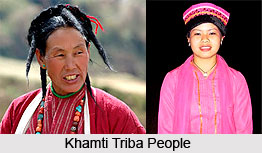 Khampti tribes are mainly concentrated in Lohit district of Arunachal Pradesh and the North Lakhimpur district of Assam. The Khamtis migrated to Assam in the second half of the 18th century. The people of this tribal group are also inhabitants of Tengapani basin. The Khamtis are among the most civilized tribes. They have their own language which is closely related with the language of the Shans of Myanmar, China and Thailand. To speak, the Khamti tribes used a dialect of the Tai script, popularly known as Lik-Tai.
The physical characteristics of the Khamti people resemble to the East Asian people.
Khampti tribes are mainly concentrated in Lohit district of Arunachal Pradesh and the North Lakhimpur district of Assam. The Khamtis migrated to Assam in the second half of the 18th century. The people of this tribal group are also inhabitants of Tengapani basin. The Khamtis are among the most civilized tribes. They have their own language which is closely related with the language of the Shans of Myanmar, China and Thailand. To speak, the Khamti tribes used a dialect of the Tai script, popularly known as Lik-Tai.
The physical characteristics of the Khamti people resemble to the East Asian people.
Occupation of Khamti Tribes
The Khamti are farmers by profession. The way they used to practice cultivation is quite unique. They practice both types of agriculture -Jhum Cultivation and settled agriculture. They produce food grains, vegetables and also cash crops. Among the food grains coarse varieties of rice, maize, millet and cotton are other important products of the Jhum cultivation. Potatoes have been introduced recently. Among the vegetables potatoes, pumpkins, cucumbers, yams are mainly cultivated. Besides this tobacco, chilli, ginger, indigo is occasionally grown.
Society of Khamti Tribes
The costumes of the Khamti men comprise of a blue, skinny jacket, made from cotton cloth. They also wear full- `siu pajai` (sleeved cotton shirt) and phanoi (deep colour lungi). Women dresses constitutes of `siu pajao` (half-sleeved blouse) and also `siu` (deep colour skirt). Siu is prepared from cotton or silk. A coloured silk scarf is also their favorite. Their jewellery consists dazzling `amber earrings` and `beaded coral necklaces`. The Khamti tribes adopted different styles of knotting their hairs with the support of a white turban. The Khamti leaders wear a Chinese coat made of silk. The topknots that the Khamti women used for tying hairs add to their beauty.
The houses of the Khamti tribes are constructed on elevated floors with `thatched` ceilings. They made these ceiling of such a low height that the walls remain hidden out. The societal structure of this tribal group is divided into different classes and they maintain their social hierarchy. The priests occupy a major position in the society. Another integral part of the life style of Khamti tribes, are individual dormitories that are built for the unmarried ladies and bachelors. In fact dormitories play a significant position in the whole of the Khamti society. Each village has its own dormitory, with youthful girls at one end and little boys at the other. The house of the maidens is considered to be a holy place and some aged maidens are in charge of these houses. Polygamy prevails among the society of the Khamtis. The chief of the Khampti is the head of the council who is responsible for the well being of the people and to settle all kinds of disputes. The Khamtis have adjusted their way of life in this eco-system by giving up many of their traditions. Khamti ardently follow Buddhism mainly Theravada School of Buddhism.
Armoury is a part of their life showing an aura of their skill as warriors. Their weapons include poisoned bamboo spikes (panjis), bow and arrows, spear, sword and shields. The Khamti also have firearms, resembling ancient `flint muskets and horse pistols`. The Khamti tribes have the preference for conventional attires. The culture of the Khamti tribes is quite enriched as depicted in their brilliant works of crafts, which had a demand in the whole of the Indian market. They made a special type of sword, locally known as dao, is popular especially amongst the people of Assam. The priests exhibit their acumen as craftsmanship in various products that they made namely wooden, bone or ivory works.
















